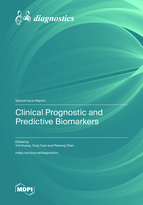Clinical Prognostic and Predictive Biomarkers
A special issue of Diagnostics (ISSN 2075-4418). This special issue belongs to the section "Pathology and Molecular Diagnostics".
Deadline for manuscript submissions: closed (30 June 2023) | Viewed by 37921
Special Issue Editors
Interests: cardiovascular disease; heart failure; diabetes; biomarkers; public health; prevention
Special Issues, Collections and Topics in MDPI journals
Interests: cardiovascular disease; heart failure; biomarkers; coronary artery disease
Special Issues, Collections and Topics in MDPI journals
Interests: laboratory medicine; precision medicine; risk prediction; clinical biomarkers
Special Issues, Collections and Topics in MDPI journals
Special Issue Information
Dear Colleagues,
Biomarkers are measurement biological variables, which can be detected in organ tissues, blood, or other body fluids. They can be mainly divided into two main types: prognostic and predictive biomarkers. Prognostic biomarkers are associated with the clinical outcomes (e.g, disease progression and recurrence, death) of the interested diseases, and are used to identify those with more aggressive disease status. Predictive biomarkers are used to identify individuals with a higher likelihood of response to a particular treatment, which allows better identification of those who are more likely to benefit from a given treatment. Generally, biomarkers can be either prognostic or predictive, while in some cases they could be used as both prognostic and predictive.
With the great advances in proteomics, metabolomics, functional genomics, and bioinformatics, more and more novel biomarkers are discovering. They play an important role in identifying high-risk individuals, diagnosing disease conditions, and predicting response to therapy and prognosis in multiple fields of clinical medicine, including cardiovascular disease, diabetes, and cancer. Furthermore, they allow us to better understand the mechanisms and molecular pathways of disease development and progression. This deeper knowledge of biomarkers offers the opportunity to develop novel precision and personalized therapies.
In this Special Issue, we aim to provide a platform for communication on the progress of biomarkers identification and utilization in healthcare. The welcomed topics include but are not limited to biomarkers in cardiovascular disease, diabetes, acute and chronic venous disease, and cancer.
Prof. Dr. Yuli Huang
Prof. Dr. Yong Yuan
Prof. Dr. Peisong Chen
Guest Editors
Manuscript Submission Information
Manuscripts should be submitted online at www.mdpi.com by registering and logging in to this website. Once you are registered, click here to go to the submission form. Manuscripts can be submitted until the deadline. All submissions that pass pre-check are peer-reviewed. Accepted papers will be published continuously in the journal (as soon as accepted) and will be listed together on the special issue website. Research articles, review articles as well as short communications are invited. For planned papers, a title and short abstract (about 100 words) can be sent to the Editorial Office for announcement on this website.
Submitted manuscripts should not have been published previously, nor be under consideration for publication elsewhere (except conference proceedings papers). All manuscripts are thoroughly refereed through a single-blind peer-review process. A guide for authors and other relevant information for submission of manuscripts is available on the Instructions for Authors page. Diagnostics is an international peer-reviewed open access semimonthly journal published by MDPI.
Please visit the Instructions for Authors page before submitting a manuscript. The Article Processing Charge (APC) for publication in this open access journal is 2600 CHF (Swiss Francs). Submitted papers should be well formatted and use good English. Authors may use MDPI's English editing service prior to publication or during author revisions.
Keywords
- biomarkers
- prognostic
- predictive
- risk stratification
- cardiovascular disease
- diabetes
- cancer
- hypertension
- heart failure
Related Special Issue
- Clinical Prognostic and Predictive Biomarkers—2nd Edition in Diagnostics (3 articles)









